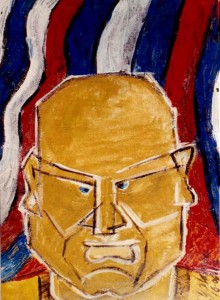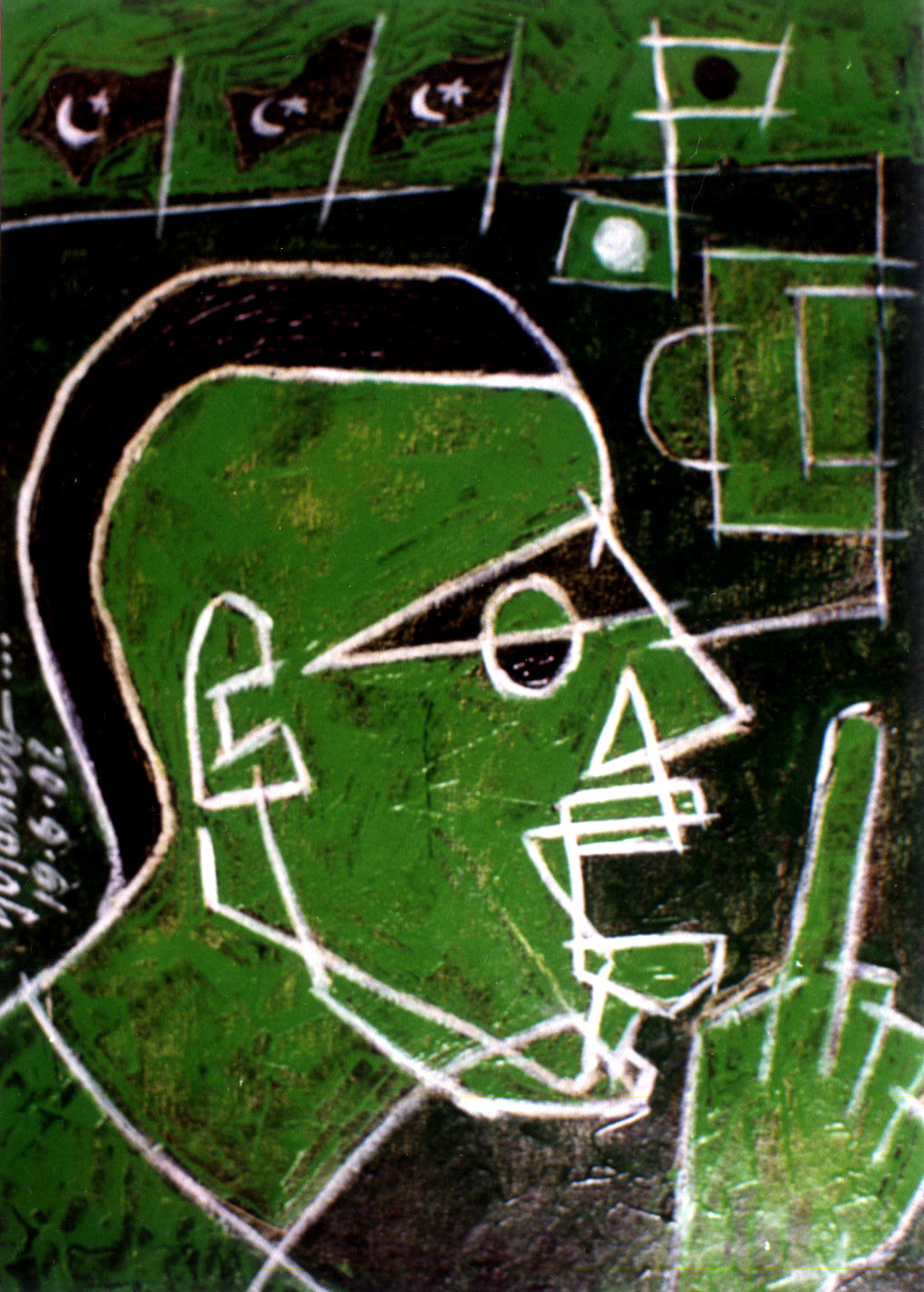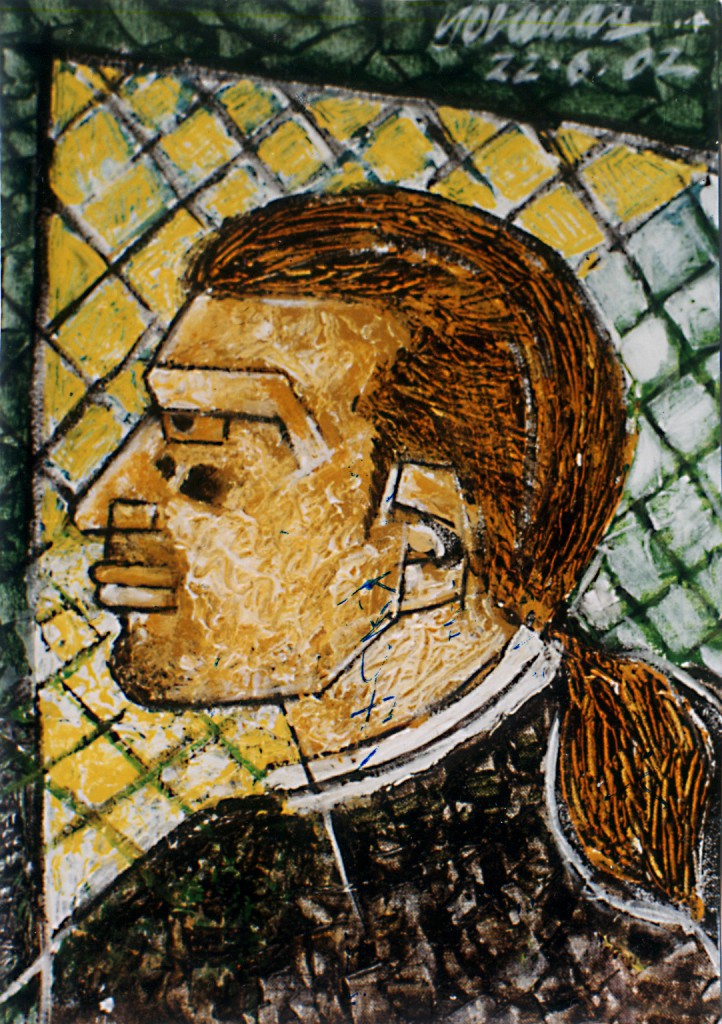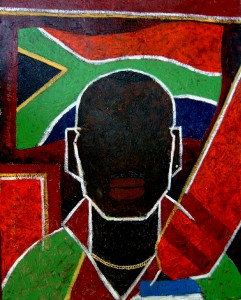
Yolanda Sousa Hammermeier, "Chilavert - The Chiller Thriller," acrylic on canvas, 2002
Chilavert is sitting on my hotel bed. The 6’4″ Paraguyan keeper cuts an imposing figure, even on canvas: his magnificent shaved head, thick neck and muscular shoulders rest on the crisp white linen of the Godwin Hotel in Colaba, Mumbai. He is looking at me as I write this. I can’t read his expression; he’s got a poker face and steely eyes. I’ve had to turn my chair away from him, which is OK because the view from my window is fine (treetops, birds, balcony gardens, and the beautiful decay of Colaba’s mansions). He came to Mumbai with me – I met him in Goa, where he was hanging out in a back hallway in Yolanda Sousa Kammermeier’s gallery. I couldn’t resist taking him home. The man is a goalkeeping legend; he is so identified with the position that his name is commonly used as a nickname for a good keeper. [By “taking him home” I mean Sousa Hammermeier’s painting of him – not the man himself. My choice of words here was deliberately confusing.]

Yolanda Sousa Hammermeier, "Umit Davala," acrylic on canvas, 2002
Goan artist Yolanda Sousa Kammermeier practices a very specific form of sport painting. She produces work in direct response to football matches, starting a painting at kickoff, and finishing it at the final whistle. Each painting is a form of match commentary. This is an impressive feat, because football demands a very particular kind of sustained attention. The game is absorbing – Juergen Teller made a work about this, filming himself watching a World Cup match. (The artist confessed that he is repulsed by his anxious contortions and whelps.)
Sousa Kammermeier watches the game differently. Her paintings have a playfulness to them. The painter is, as it happens, a former football player, and a signficant athlete in Indian sports history. Goa, a former Portugese colony, is football-mad. AC Milan and Argentina jerseys are on the backs of half the boys you see driving their scooters around the cows, goats, and pigs who seem to own the roads. The time difference between Goa and the EU means that you can watch Premiership matches from the disco floor, and people do. (I watched Manchester City defeat Chelsea last week, while dancing to Beyoncé with India’s no. 1 goalkeeper and player of the year, Subashish Roy Chowdhary.) Villages all have pitches, and those pitches are in constant use (rested only in the full heat of the day). The region hosts the country’s best club at the moment (Churchill brothers, based in Margao) and India’s national soccer teams (men and women) hold their training camps in the region. In the late 1970s and early 1980s, Goa hosted a thriving women’s football scene. Sousa Kammermeier was a star in that world, celebrated for what seems to have been a natural inclination to score hat tricks (three goals in a single match). At her heydey, she was heralded in the press as the “Madonna of Goan Football.” That’s no small title to hold in the intensely Catholic region.

Yolanda Sousa Hammermeier, "Rustu Recber," acrylic on canvas, 2002
To date, my conversation with Sousa Kammermeier was the densest I’ve had with any of the soccer-folks I’ve met on my trip. Even though I’ve written explicitly against the desire to read art and sport in opposition to each other, when I approached the painter, I did so with certain assumptions about her relationship to soccer and art. I assumed that she felt like an outsider in football, as an artist and also a woman. It turns out I couldn’t have been more wrong.
Her memories of coming into football are fond – the first practice session she organized for girls in her village was held on the beach. Boys saw the girls and asked why they weren’t using the soccer field. From then on, she recalls the day-to-day experience of playing as a girl and young woman very positively (her recollections of the administration of the sport nationally is another matter, which I will address in my soccer blog). She was an art student from early on, and found that the only conflict between that world, and the world of sport was in time; once she started competing in national tournaments and traveling as a member of India’s national women’s team (competing in the first modern-day versions of a women’s world cup), she found it hard to navigate the demands of school and sport. Incredibly, her schools – and then later her employers – worked around her training schedule. Yolanda speaks of her youth as one who felt a community of support behind her, and with the groundedness of a person who has felt that community’s investment in the full realization of her talents. She wishes no less for India’s contemporary athletes.
Perhaps the largest genre of sport-art is that made by the fan. YouTube is full of these works: homages to a favorite athlete, scored to a favorite song. I imagine compiling those things must be time consuming. Soccer capitals usually have at least one shop which sells fan-art: black and white photographs of players looking heroic, shots of fans going crazy in the stands, or the melancholy of an empty (and historic) stadium. Sousa Kammermeier’s work is not of that genre: it is less a portrait of players and teams and more nearly a rendition of what she saw.

Yolanda Sousa Hammermeier, "Lara's Theme" (Cricket World Cup), acrylic on canvas, 2003
She does the same for cricket matches, in fact, and there I think we get to see her luxuriate in both the melodrama of the national sport (responding to headline scandals) and in its intensely graphic sensibilities.
Her paintings have a sense of humor that I associate less with visual representations of sports, and more with sports writing (the best of which transcends sarcasm to embrace the absurd). Perhaps this is because each painting stands as Sousa’s story of the match.

Yolanda Sousa Hammermeier, "Barthez conquered!" acrylic on canvas, 2002
I am not sure what World Cup match inspired her portrait of Chilavert; that painting is unusual, as Paraguay’s opponent is invisible (the colors in the background are Paraguay’s own). His opponent seems to have been irrelevant to Sousa Hammermeier. His teammates have also disappeared. (Chilavert’s egotism and lack of interest in his teammates was a frequent source of complaint.) I suspect that it was Chilavert’s last match in that tournament, in which Paraguay lost to Germany (1-0).
Chilavert is a great subject. He was notoriously outspoken and hot-tempered as a player. He started the 2002 tournament with a suspension – earned for spitting on a Braziilan player who’d insulted him with a racist comment. He refused to play in the Copa America in 1999 – Paraguay was hosting the celebrated tournament. He felt the poor country ought to be spending its money on education, and he said so. He’s an unusual guy. He’s got ideas. And she saw it in his eyes.




Pingback: What’s Cookin at the Art21 Blog: A Weekly Index | Art21 Blog
Pingback: Yolanda de Sousa’s Mundial Scrapbook – The Sport Spectacle